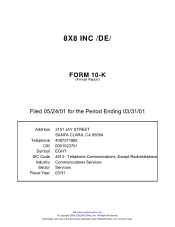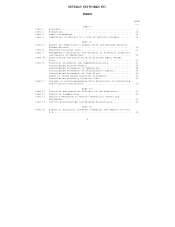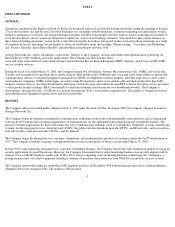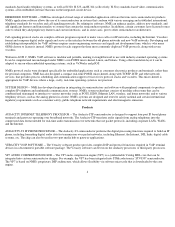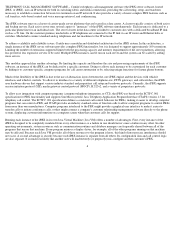8x8 2001 Annual Report Download - page 11
Download and view the complete annual report
Please find page 11 of the 2001 8x8 annual report below. You can navigate through the pages in the report by either clicking on the pages listed below, or by using the keyword search tool below to find specific information within the annual report.The iPBX solution was designed to address the shortcomings of traditional Centrex service offerings in a number of ways as described below.
- The use of an IP network allows the iPBX to scale relatively easily and economically because subscribers can add additional extensions
without adding a new cable for each extension. Additional IP phones are plugged into the existing LAN.
- The iPBX uses an IP network instead of a circuit-switched one so it can be located in the service provider's data center which may be miles
away from the customer enterprise premise and connected to it by only a single broadband IP link.
- The redundancies built into the system increase its reliability, particularly when compared to enterprise owned PBXs. The Company also
offers a monitoring service, in partnership with its customers, via a Network Operations Center (NOC) to minimize service outages and
downtime of the iPBX network.
Products
IPBX SERVER SOFTWARE --
Introduced in March 2000 and commercially released for general availability in March 2001, the Centile iPBX
server software runs on a cluster of five Sun Microsystems Netra T1s to provide software PBX functionality over IP networks. The iPBX
software was designed specifically to allow service providers to deliver hosted iPBX services to small and medium-sized business customers.
The Centile iPBX will allow service providers to support up to eighty discrete iPBXs per cluster, each dedicated to an individual customer, and
up to five thousand total extensions.
The Netra cluster running the iPBX server software is located in the service provider's data center. It is connected to the customer's premise
using any broadband IP connection, though deployments to date have generally utilized a T1 connection. For telephone sets, customers can use
media hubs to adapt standard analog telephones to IP service or they can use IP phones. The iPBX server software connects to the PSTN and
the long-distance IP backbone through a gateway.
Service providers control and configure the iPBX server software via a Web interface, allowing the system administrator to manage the iPBX
from any location using any workstation with a browser. Centile also offers a Network Operations Center (NOC) service (discussed below) to
provide service provisioning and network monitoring services. The administrator interface is designed to provide control of phone number
block assignments, dial plans, service provisioning, DID assignments, iPBX status, bandwidth management, and network topology. The iPBX
supports external billing, voicemail, interactive voice response, automatic call distribution, auto attendants, directory service, unified messaging
modules, and OSS (operation, service, and support) integration.
MH4 MEDIA HUB -- Media hubs are customer premise equipment that adapt conventional telephony equipment, such as analog telephones
and fax machines, for IP service. Centile's MH4 media hub product supports four analog lines. Centile currently uses the Company's MH4
product, along with certain IP phones and media hubs developed by third parties, in its hosted iPBX business communication service
deployments.
Each media hub supports as many simultaneous connections as it has analog lines and multiple media hubs can be used in an IP telephony
system to provide as many lines as required. Because it uses a standard touch-tone telephone as both its audio and user interface, media hub-
based systems are both reliable and cost-effective, especially when compared to proprietary digital PBX telephones.
MH4 media hubs support the MGCP IP telephony standard with Centile extensions for auto-discovery and configuration. All media hubs
deployed by Centile incorporate FLASH memory for remote upgrade capability so that the Centile iPBX server software can upgrade media
hubs automatically via the network as required.
IPBX USER INTERFACE SOFTWARE -- Centile has announced three user interface applications for its hosted iPBX solution:
Communication Center, Switchboard, and Administrator. All of these applications are designed to harness the graphical capabilities of personal
computers and workstations to make the hosted iPBX easy to use.
7

